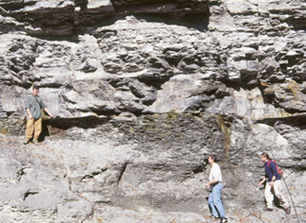News
Notes
Mass
extinction
New suspect
for Late Devonian die-off
A meteor impact may have caused the Late Devonian extinction, one of
the longest lasting in history, but scientists have also implicated global
warming, global cooling, sea level change and oxygen depletion. Now a new
twist throws into doubt some long-standing geologic assumptions, and names
eutrophication as the extinction culprit.
The three-million-year long event, known as the Frasnian-Fammenian extinction,
decimated low-latitude tropical reef ecosystems and shallow-water marine
faunas during the Middle Devonian to Late Devonian period.
In the June issue of Paleoceanography, Adam E. Murphy of Northwestern
University and colleagues challenged the traditional hypothesis that black
shale deposits formed only from fully stratified oceans, where nutrient
mixing on geologic time scales was at a minimum. Their new interpretation
of the shales supports earlier research indicating eutrophication as a
mechanism in the Late Devonian mass extinction. Not involved in the study,
marine scientist Ellery Ingall of the University of Texas at Austin considered
the project well thought out. “They presented ideas that will be applicable
to many debates in geology in addition to the issue of the Devonian extinction.”
| Investigating shale layers from the Geneseo Formation in New York,
the scientists found evidence suggesting that the Devonian seas actually
oscillated between episodes of seasonal thermocline establishment and periods
of water column mixing. Their model predicted that the fluctuating
seas released nutrients that stimulated increased primary productivity
and maintained the formation of the black shale deposits. The shifting
seas, combined with relative sea level change, basin deepening and sediment
starvation, caused periodic and widespread eutrophication of Devonian shallow-water
sea systems.
“They have articulated an intriguing and impressive model, but it may
be too good,” says J. Barry Maynard, a sedimentary geologist from the University
of Cincinnati. “That is, it may be too broadly applicable to explain the
Devonian extinction.” |

Lead author Adam Murphy points to the boundary between the
Moscow Shale and the Geneseo Shale at the Fall Brook locality
near Geneseo, N.Y. Also in the photo are project collaborator
Tim Lyons and his student, Mike Formolo.
Photo courtesy of Bradley B. Sageman. |
In an earlier paper published in the May issue of Geology, Murphy,
Bradley B. Sageman and David J. Hollander suggested that it was these eutrophication
events that ultimately ravaged Devonian biodiversity.
They analyzed the atomic burial ratios of carbon, nitrogen and phosphorous
in the Upper and Lower Kellwasser horizons, layers of black shale found
in western New York and deposited in an offshore, tropical region during
the late Frasnian stage. Amidst the cornucopia of buried organic carbon
they discovered an anomalous paucity of both phosphorous and nitrogen.
During photosynthesis, carbon, nitrogen and phosphorous are incorporated
in algal organic matter. When oxygen levels vary bacteria in the lower
water column and sediments tend to release more nitrogen and phosphorous
back into the sea as they decompose dead organic matter. Consequently,
a surplus of carbon gets buried. According to their new model of ocean
circulation, Sageman says, during the late Devonian period this process
could have resulted in the excess burial of carbon seen at the Kellwasser
Horizons and at a series of black shales leading up to them.
Nitrogen and phosphorous availability in the water column would have
skyrocketed during these intervals, Sageman says, leading to an explosion
in primary productivity. Because tropical to subtropical organisms in the
Devonian period most likely adapted to low nutrient, clear-water conditions
the proposed eutrophication events would have had a major impact.
Massive blooms of phytoplankton would have eclipsed surface water clarity,
snuffing out planktic and nektic communities, Sageman says. In the lower
water column, widespread oxygen deficiency would have demolished benthic
communities. Over the course of a few million years, he says, such events
would have completely dismantled the Late Devonian shallow-water marine
ecosystem.
Felix Gilette
Geotimes contributing
writer

